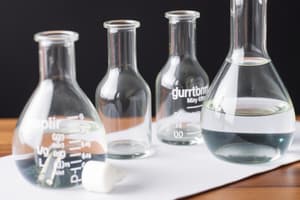Podcast
Questions and Answers
What type of property or change are heat conductivity, length of a metal object, and brittleness?
What type of property or change are heat conductivity, length of a metal object, and brittleness?
- Chemical Property
- Physical Property (correct)
- Chemical Change
- Physical Change
What type of property or change are silver tarnishing, exploding dynamite, wood burning, and milk souring?
What type of property or change are silver tarnishing, exploding dynamite, wood burning, and milk souring?
- Chemical Property
- Physical Change
- Physical Property
- Chemical Change (correct)
What type of property or change are sublimation, magnetizing steel, and water freezing?
What type of property or change are sublimation, magnetizing steel, and water freezing?
- Chemical Property
- Physical Property
- Chemical Change
- Physical Change (correct)
What type of property or change are combustible materials and acid resistance?
What type of property or change are combustible materials and acid resistance?
A change in size or shape is a physical change.
A change in size or shape is a physical change.
A chemical change means a new substance with new properties was formed.
A chemical change means a new substance with new properties was formed.
An example of a chemical change is when water freezes.
An example of a chemical change is when water freezes.
When platinum is heated and then cooled back to its original state, this is a physical change.
When platinum is heated and then cooled back to its original state, this is a physical change.
When milk turns sour, this is a physical change because a change in odor does not indicate a chemical change.
When milk turns sour, this is a physical change because a change in odor does not indicate a chemical change.
When citric acid and baking soda mix, carbon dioxide is produced and the temperature decreases. This must be a chemical change.
When citric acid and baking soda mix, carbon dioxide is produced and the temperature decreases. This must be a chemical change.
Identify if it is a chemical or physical change: You leave your bicycle out in the rain and it rusts.
Identify if it is a chemical or physical change: You leave your bicycle out in the rain and it rusts.
Identify if it is a physical or chemical change: A sugar cube dissolves.
Identify if it is a physical or chemical change: A sugar cube dissolves.
Identify if it is a chemical or physical change: Scientists break up water into oxygen and hydrogen gas.
Identify if it is a chemical or physical change: Scientists break up water into oxygen and hydrogen gas.
Identify if it is a chemical or physical change: Burning coal for a barbecue.
Identify if it is a chemical or physical change: Burning coal for a barbecue.
Identify if it is a chemical or physical change: Trimming a bush because it has grown too tall.
Identify if it is a chemical or physical change: Trimming a bush because it has grown too tall.
Do substances undergo a physical or chemical change during a chemical reaction?
Do substances undergo a physical or chemical change during a chemical reaction?
Determine if a chemical reaction is happening: A girl cuts a piece of paper; A boy dissolves salt in water?
Determine if a chemical reaction is happening: A girl cuts a piece of paper; A boy dissolves salt in water?
Determine if a chemical reaction is happening: A man uses chemicals to remove rust from metal; A teacher burns wood; A plant converts water and carbon dioxide into sugar and oxygen?
Determine if a chemical reaction is happening: A man uses chemicals to remove rust from metal; A teacher burns wood; A plant converts water and carbon dioxide into sugar and oxygen?
In some chemical reactions, light is produced or temperature changes. What is going on between the substances in the reaction? What could cause these things to occur?
In some chemical reactions, light is produced or temperature changes. What is going on between the substances in the reaction? What could cause these things to occur?
What does the law of conservation of mass state?
What does the law of conservation of mass state?
What is a balanced chemical equation?
What is a balanced chemical equation?
A student conducts an experiment to observe a reaction between two substances. She records the mass of the substances combined to be 10 grams. She mixes the substances together and observes the reaction. The two substances combine to form a single product. What is the mass of the product?
A student conducts an experiment to observe a reaction between two substances. She records the mass of the substances combined to be 10 grams. She mixes the substances together and observes the reaction. The two substances combine to form a single product. What is the mass of the product?
How do we apply the law of conservation of mass to chemical equations?
How do we apply the law of conservation of mass to chemical equations?
What is the difference between an unbalanced and balanced chemical equation?
What is the difference between an unbalanced and balanced chemical equation?
How can you manipulate an unbalanced equation to make it balanced?
How can you manipulate an unbalanced equation to make it balanced?
Flashcards are hidden until you start studying
Study Notes
Properties and Changes of Matter
- Heat conductivity, length of a metal object, and brittleness are classified as physical properties.
- Silver tarnishing, exploding dynamite, wood burning, milk souring, and breaking bread are examples of chemical changes.
- Sublimation, magnetizing steel, shortening melting, and water freezing are categorized as physical changes.
- combustibility and acid resistance are examples of chemical properties.
True or False Statements
- A change in size or shape is indeed a physical change.
- A chemical change produces a new substance with different properties.
- Water freezing is not a chemical change; it is a physical change.
- Heating and cooling platinum to its original state is classified as a physical change.
- Milk turning sour is a chemical change, not a physical one.
Change Identification
- Rusting of a bicycle left in the rain is a chemical change.
- Dissolving a sugar cube is a physical change.
- Breaking water into oxygen and hydrogen gas represents a chemical change.
- Burning coal for a barbecue involves a chemical change.
- Trimming a bush is a physical change.
Chemical Reactions and Conservation of Mass
- Chemical reactions involve chemical changes in substances.
- Cutting a piece of paper or dissolving salt in water do not indicate chemical reactions.
- Using chemicals to remove rust, burning wood, and photosynthesis in plants involve chemical reactions.
- Chemical reactions can produce light or change temperature due to energy transfer.
- The Law of Conservation of Mass states that matter cannot be created or destroyed.
Chemical Equations
- A balanced chemical equation has the same number of atoms on both reactant and product sides.
- In an experiment, if two substances combine to weigh 10 grams, the mass of the product remains 10 grams.
- To apply the Law of Conservation of Mass, the number of atoms must remain constant on both sides of a reaction.
- An unbalanced equation has differing atom numbers on each side, while a balanced equation has equality.
- To balance an unbalanced equation, adjust coefficients in front of molecules to equate the number of atoms.
Studying That Suits You
Use AI to generate personalized quizzes and flashcards to suit your learning preferences.




